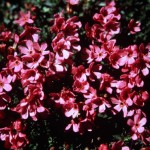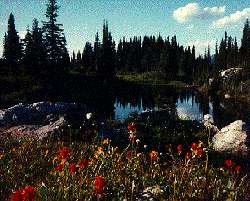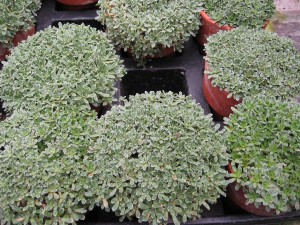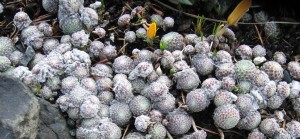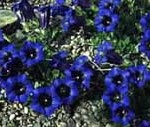The plant world converses in a tonal wonderful array of greens, and sometimes not. All plant species evolved out of lichens and mosses so I feel it appropriate to concentrate on the small and miniature. Are they props or do they deserve equal attention to the trees that rise above?
If the world is a body, the mountains or rocks therein, must be the skeleton and her arteries are the rivers and ponds that course around, the trees and plants beneath being the lungs. All of these elements are in communication and must be in constant interaction. These are the thoughts that humans sometimes breath in and from time to time and sometimes understand.
The sedum that had stayed stunted and demure in its alpine setting is now well watered throughout and has now stolen the show! A Bonsai master added good commentary: …”you rejoice about them twice: first when you establish them, and next when you succeed in getting rid of them.” Well said!.
The best rock garden plants generally thrive in full sun and as alpines they mostly occur above the tree line and thrive in scree and suffer under very harsh conditions. Moreover they are controlled by strict limitations to the growing cycle. This is often limited to what we lowlanders would understand as a thirty-day growing period (without frost). Lichens and mosses can exist even with freezing conditions that happen every day.
That said, many alpine plants fit in admirably with bonsai. Being resilient they will survive in any well drained soil mixture and more often than not will accept much dryer conditions than the bonsai they now mix roots with. The saxifrage and sempervivum families are the first that come to mind.
In the Pacific Northwest we should find no difficulty in keeping these tiny gems alive. In California or the more humid areas of the South or East coast this may not be the case. Their original home might have been the Pyrenees or the Rockies. In all cases they are used to long periods of snow and dormancy. Even in our low heat degree area, they can hyperventilate and grow so fast as to leave dead centers and must then be re-divided and begun anew.
As bonsai need to be re-potted every few years, this should pose no problem. Some will re-seed naturally and others simply should be divided during or just before their own growing season. With benign neglect (little fertilizing) these miniatures will remain in scale with your bonsai. Over fertilizing and too much shade may cause the results as shown with my sedum oak grove.
Some of these miniature companions may not even be alpine in nature, so some research should be done. As in human beings, couplings should stress “compatibility” not the Mars/Venus thing. A good example would be Corokia cotoneaster with Rauolia australis; both are from down under and have similar requirements. Saxifrage petrophylla might be another combination, simply because of color and foliage compatibility.
The possibilities are diverse. My own following selection is just a beginning and if you come to love these alpines, I suggest you join the American Rock Garden Society.
Arneria capillaris (Mountain sandwort ) Or the tiny plant of Alpine Saxifrage looks forward to better days after marmot or deer dropping nutrients arrived. Saxifraga petrophylla, S. tolmei,
Sempervivums — esp. the arachniodies tometntosum group.
Sedums — be very careful. What I used in one bonsai was S. dasyphullum. There are even smaller forms such as S. atlanticum. Thymus or T. serpylum ‘Minus. (Elfin Thyme)
Some small bulbs such as Allium senescens pulchellum, N. bulbicodium, Dodecatheon (Shooting star) or Rhodohypoxis might be wonderful to add should you want to add some color to your spring or early summer display. Alas, they may die and will need to be replaced as the constant moisture needs of the shallow bonsai container will ultimately kill them, as they need summer dryness. In larger and deeper containers they will do fine.
Some candidates are still on a margin call.Cotula squalida (Brass Buttons) may like Irish moss simply steal too much nutrition from the plant. To that end, I put some in with one of my larger plants and a tough one at that. We will see. All experiments do not always work, but when they do it is a wonder. As Bita Duflon once said about Cotula, this is a good plant to wipe ones feet on. Bita and her husband Alton discovered the Olympic native Abies lasiocarpa ‘Duflon’.’
All Bonsai lovers would treasure this extremely slow-growing Abies. This sub-alpine Fir puts on less than a 1/2″ of new growth a year. Medium green needles cover the tight globe densely. Discovered near Lake Cushman, Washington, the parent tree died, but fortunately their friend and nurseryman, Ed Lohbrunner rooted five of the cuttings and the cultivar was saved.
Many years later I am still taking care of some of these green ‘Duflons’, while Bita’s ashes reside quietly in the Olympics she so loved. The ashes we leave behind become a new story all their own.
(C) 2009 Herb Senft All rights reserved.

